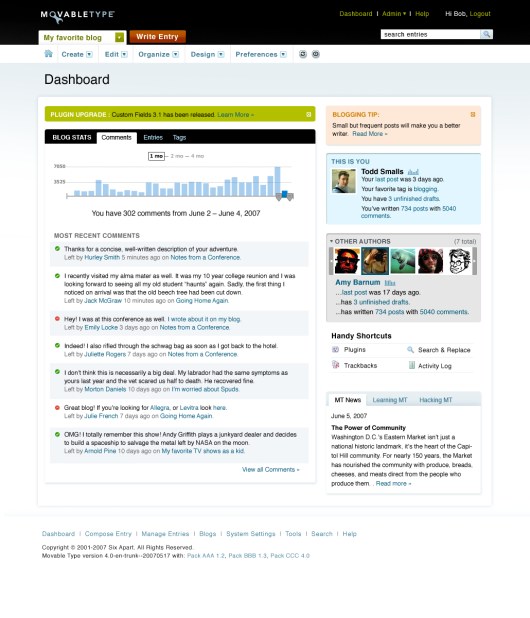My new pal Baratunde asked on Twitter last week for info, examples or anecdotes about companies using new online social media for marketing. I thought I should type up some thoughts about what we’ve done at SplashCast so far because I think we’ve done a particularly good job of it. I thought I’d post it here in hopes that others would find it useful as well. It’s rough around the edges but I thought not posting it would be a lost opportunity.
If you haven’t checked out SplashCast yet, you can see just one example of its many capabilities in the podcast player on my sidebar here.
SplashCast’s Use of Social Media for Marketing
 SplashCast has hired two experienced social media producers, myself and Alex Williams [that’s Alex on the right], founder of the Podcast Hotel series of podcasting industry conferences. One of our big responsibilities is what I call in-house content production to engage with existing social media communities.
SplashCast has hired two experienced social media producers, myself and Alex Williams [that’s Alex on the right], founder of the Podcast Hotel series of podcasting industry conferences. One of our big responsibilities is what I call in-house content production to engage with existing social media communities.
I write blog posts that are accompanied by channels of mixed media content compiled using our company’s product. Alex publishes interviews from events using SplashCast.
My primary media production activity at SplashCast is similar to what I’ve done when working for content companies (TechCrunch, AOL Social Software Weblog, NetSquared and others). I try to break news, publish mixed media content related to existing online discussions and otherwise add value to the media landscape for readers interested in the emerging online video market. The goals of this work are to drive traffic the SplashCast website, demonstrate the potential of our publishing tool and ultimately to encourage people to sign up as SplashCast publishers themselves. Plus it’s a whole lot of fun for me.
The primary ways that we work to build readership for our blog are these:
*Daily blogging, not only about company news but interesting industry news as well. Some of our posts have been deemed interesting enough
to receive thousands of visitors from StumbleUpon, for example.
*Sending trackbacks to other blogs, where our posts that are related to theirs are linked for their readers to discover.
*Leaving thoughtful, value-ad-focused comments in response to posts on other blogs, where our names are linked to the SplashCast site added in the URL field of the comment form.
*Putting relevant bloggers at the center of our strategy for company and new product release PR. That strategy lead to more than 250 blog mentions within 48 hours of our launch, for example.
*Attending events and building relationships with other social media producers, who will think of us later when writing about related subject matter.
*We also use Twitter to stay abreast of what other people are doing and keep friends up to date on what we’re doing at SplashCast.
*Engegement with and inclusion in relevant topical aggregators. This is a big part of what we do. For example, a Google search of Techmeme.com for SplashCastMedia brings back 1,400 results and we’ve now made 15 appearances on the front page of Digg. Both easier said than done, but both great sources of traffic and lead generation.
All of these steps could have been done well or poorly, but because we have two experienced social media producers in house we believe we can effectively communicate in such a way that our commercial message is more implied than it is overbearing. (For another perspective on appropriate marketing communication in new media, see this very smart post written by Jeremy Pepper.)
The high level themes of our work, I believe are the following:
*We find creative ways to participate in conversations of general interest. In particular, we let people publish aggregated collections of mixed media, so we watch the news and see what would be interesting to publish collections like this about. When the DoD banned social media sites from official networks, we published a channel of videos and photos tagged Iraq in YouTube and Photobucket, for example.
*Timeliness has been important – we work hard to cover news as early in the news cycle as possible. That’s a whole other topic that requires its own strategy.
*Helping people do their own work better. This is becoming cliche in the web 2.0 world, but it bears repeating. Our posts on things you can do with mixed media RSS, ways you can tag videos and how you can build a successful website around aggregated media were all big hits.
*Finding the balance between marketing and conversation. It’s no secret that the SplashCast blog is trying to convince people to use our product, so we don’t hide that. We do however try to make our posts compelling enough to be interesting on their own merits, regarding general interest topics, whether you care to try SplashCast or not.
As a result of implementing this strategy before, during and after our initial launch, we had more than 1,000 publishers register for an account at launch, we doubled that in our first month to 2,000 and doubled it again in our second month to more than 4,000. SplashCast player loads are now aproaching 5.5 million.
As a social media service company, it also makes sense for us to do a lot of in house content production so that we know the application, its possibilities and performance issues, as best as possible. That said, I believe that any company can benefit greatly by adding social media participation and content production to the center of their marketing strategy. The use of social media has proven enormously helpful to SplashCast.
The roll of social media in a market sector in a relatively commoditized sector is something else that could use some further consideration.
I hope you’ll stop by SplashCastMedia.com, see this work in action for yourself and create an account to publish your collections of mixed media. If you would like my help in coming up with a strategy like this for your company, drop me a line. I can be reached at marshall@marshallk.com
 SixApart’s Anil Dash pinged me yesterday and said that the basics are this: MT 4.0 will go open source in Q3 and it will incorporate lessons learned from other SA products – the media handling and templates of Vox, the publishing control of Typepad, the scalability and OpenID support of LiveJournal. That sounds very intriguing to me; I’ll be checking out MT the next time I set up any website and recommend that others look at it as well, in addition to WordPress. I hope it’s easier to install and customize. Let’s be honest, that project logo above doesn’t evoke the kinds of smooth user experience that it ought to. There is a WP to MT importing tool available, that’s good news.
SixApart’s Anil Dash pinged me yesterday and said that the basics are this: MT 4.0 will go open source in Q3 and it will incorporate lessons learned from other SA products – the media handling and templates of Vox, the publishing control of Typepad, the scalability and OpenID support of LiveJournal. That sounds very intriguing to me; I’ll be checking out MT the next time I set up any website and recommend that others look at it as well, in addition to WordPress. I hope it’s easier to install and customize. Let’s be honest, that project logo above doesn’t evoke the kinds of smooth user experience that it ought to. There is a WP to MT importing tool available, that’s good news.
 SplashCast has hired two experienced social media producers, myself and Alex Williams [that’s Alex on the right], founder of the Podcast Hotel series of podcasting industry conferences. One of our big responsibilities is what I call in-house content production to engage with existing social media communities.
SplashCast has hired two experienced social media producers, myself and Alex Williams [that’s Alex on the right], founder of the Podcast Hotel series of podcasting industry conferences. One of our big responsibilities is what I call in-house content production to engage with existing social media communities. Ha ha ha – the snazzy laptop I got in the mail from Microsoft yesterday was the only way I was ever going to use Vista anyway. And I’m certainly never going to take a laptop with a stupid looking Ferrari logo on the front anywhere but home and my cube at work.
Ha ha ha – the snazzy laptop I got in the mail from Microsoft yesterday was the only way I was ever going to use Vista anyway. And I’m certainly never going to take a laptop with a stupid looking Ferrari logo on the front anywhere but home and my cube at work.